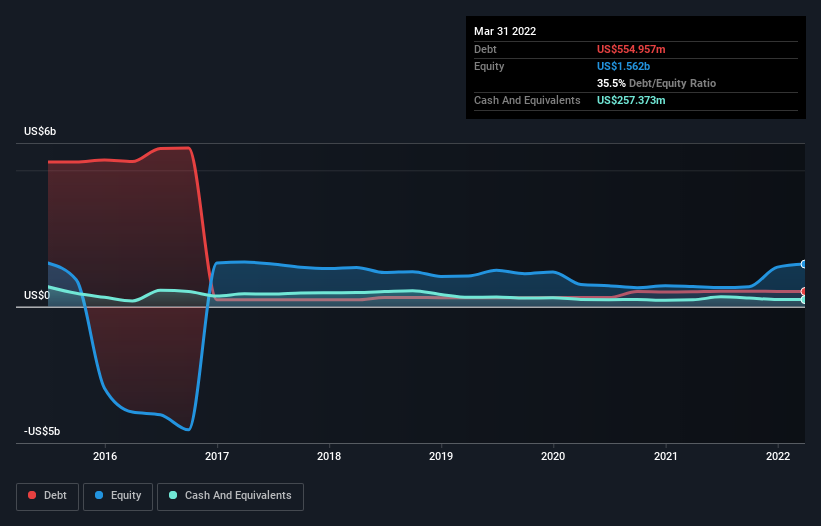Warren Buffett famously said, 'Volatility is far from synonymous with risk.' When we think about how risky a company is, we always like to look at its use of debt, since debt overload can lead to ruin. We note that Frontera Energy Corporation (TSE:FEC) does have debt on its balance sheet. But should shareholders be worried about its use of debt?
Why Does Debt Bring Risk?
Generally speaking, debt only becomes a real problem when a company can't easily pay it off, either by raising capital or with its own cash flow. Ultimately, if the company can't fulfill its legal obligations to repay debt, shareholders could walk away with nothing. However, a more common (but still painful) scenario is that it has to raise new equity capital at a low price, thus permanently diluting shareholders. Of course, the upside of debt is that it often represents cheap capital, especially when it replaces dilution in a company with the ability to reinvest at high rates of return. When we think about a company's use of debt, we first look at cash and debt together.
View our latest analysis for Frontera Energy
What Is Frontera Energy's Debt?
The chart below, which you can click on for greater detail, shows that Frontera Energy had US$555.0m in debt in March 2022; about the same as the year before. However, because it has a cash reserve of US$257.4m, its net debt is less, at about US$297.6m.

A Look At Frontera Energy's Liabilities
Zooming in on the latest balance sheet data, we can see that Frontera Energy had liabilities of US$644.3m due within 12 months and liabilities of US$554.3m due beyond that. On the other hand, it had cash of US$257.4m and US$188.4m worth of receivables due within a year. So it has liabilities totalling US$752.8m more than its cash and near-term receivables, combined.
This deficit is considerable relative to its market capitalization of US$907.6m, so it does suggest shareholders should keep an eye on Frontera Energy's use of debt. This suggests shareholders would be heavily diluted if the company needed to shore up its balance sheet in a hurry.
We measure a company's debt load relative to its earnings power by looking at its net debt divided by its earnings before interest, tax, depreciation, and amortization (EBITDA) and by calculating how easily its earnings before interest and tax (EBIT) cover its interest expense (interest cover). This way, we consider both the absolute quantum of the debt, as well as the interest rates paid on it.
Frontera Energy has a low net debt to EBITDA ratio of only 0.29. And its EBIT easily covers its interest expense, being 22.2 times the size. So we're pretty relaxed about its super-conservative use of debt. It was also good to see that despite losing money on the EBIT line last year, Frontera Energy turned things around in the last 12 months, delivering and EBIT of US$875m. There's no doubt that we learn most about debt from the balance sheet. But ultimately the future profitability of the business will decide if Frontera Energy can strengthen its balance sheet over time. So if you want to see what the professionals think, you might find this free report on analyst profit forecasts to be interesting.
Finally, a company can only pay off debt with cold hard cash, not accounting profits. So it is important to check how much of its earnings before interest and tax (EBIT) converts to actual free cash flow. Over the last year, Frontera Energy recorded negative free cash flow, in total. Debt is far more risky for companies with unreliable free cash flow, so shareholders should be hoping that the past expenditure will produce free cash flow in the future.
Our View
We feel some trepidation about Frontera Energy's difficulty conversion of EBIT to free cash flow, but we've got positives to focus on, too. To wit both its interest cover and net debt to EBITDA were encouraging signs. Taking the abovementioned factors together we do think Frontera Energy's debt poses some risks to the business. So while that leverage does boost returns on equity, we wouldn't really want to see it increase from here. When analysing debt levels, the balance sheet is the obvious place to start. However, not all investment risk resides within the balance sheet - far from it. We've identified 1 warning sign with Frontera Energy , and understanding them should be part of your investment process.
If, after all that, you're more interested in a fast growing company with a rock-solid balance sheet, then check out our list of net cash growth stocks without delay.
New: AI Stock Screener & Alerts
Our new AI Stock Screener scans the market every day to uncover opportunities.
• Dividend Powerhouses (3%+ Yield)
• Undervalued Small Caps with Insider Buying
• High growth Tech and AI Companies
Or build your own from over 50 metrics.
Have feedback on this article? Concerned about the content? Get in touch with us directly. Alternatively, email editorial-team (at) simplywallst.com.
This article by Simply Wall St is general in nature. We provide commentary based on historical data and analyst forecasts only using an unbiased methodology and our articles are not intended to be financial advice. It does not constitute a recommendation to buy or sell any stock, and does not take account of your objectives, or your financial situation. We aim to bring you long-term focused analysis driven by fundamental data. Note that our analysis may not factor in the latest price-sensitive company announcements or qualitative material. Simply Wall St has no position in any stocks mentioned.
About TSX:FEC
Frontera Energy
Engages in the exploration, development, production, transportation, storage, and sale of oil and natural gas in South America.
Good value with adequate balance sheet.
Similar Companies
Market Insights
Community Narratives



